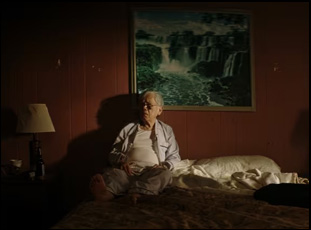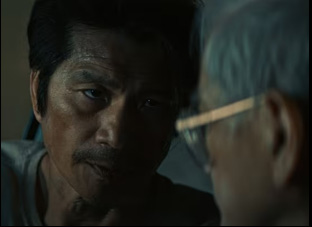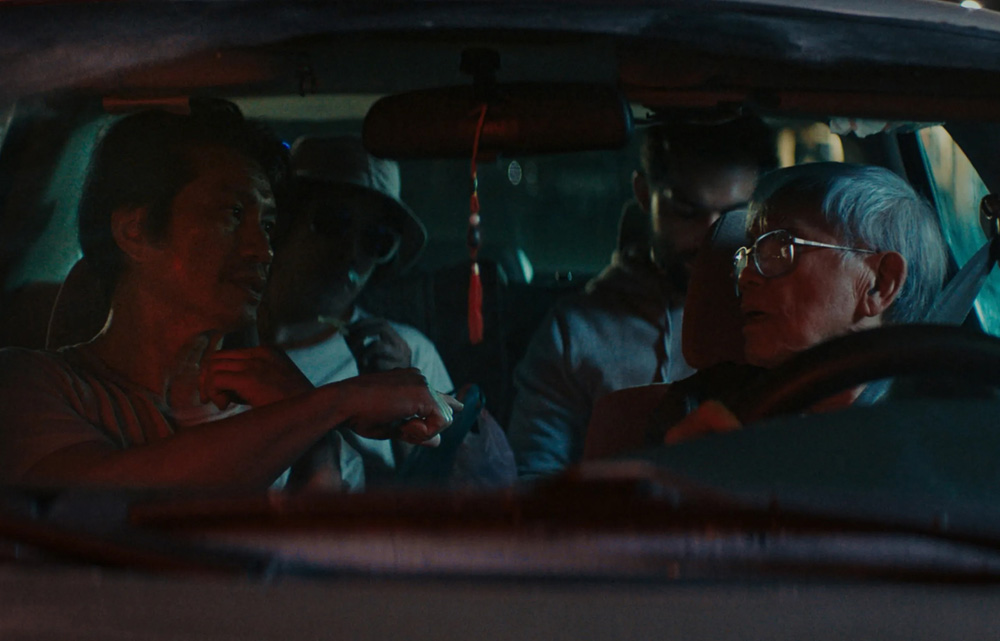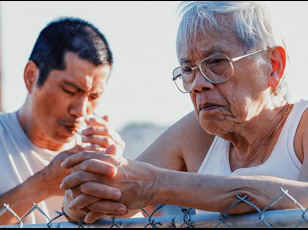There’s never a moment’s doubt in “The Accidental Getaway Driver” that Long Ma (Hiep Tran Nghia) shouldn’t trust his first instinct about taking one last fare for the night, initially declining a call from dispatch saying that it’s too late at night. Headed home after stopping at a supermarket in his adopted home of Little Saigon in Orange County, he’s unswayed by a second call, telling him “it’s a local ride and won’t be far” and isn’t convinced until it’s clear if he doesn’t, he may not be on the job for much longer. His worst fears are realized as three men hustle into his car, two more than he was expecting and give him no more direction than “Just keep driving” when he asks where they want to go.
Long Ma may be surprised where the evening takes him, eventually coming to learn that Tay (Dustin Nguyen), Aden (Dali Benssalah) and Eddie (Phi Vu) are on the run after exiting a maximum security prison on their own terms, but so too will an audience when Sing J. Lee’s feature debut isn’t what you’d expect. From a producing team that includes the likes of “John Wick” producer Basil Iwanyk and longtime James Bond backer Barbara Broccoli (not to mention “Manchester by the Sea” producer Kimberly Steward), the film doesn’t disappoint in taking people for a wild ride, but when the cab driver is no Ryan Gosling-esque wheelman, it becomes a journey into the soul as each of the men in the car want to make a break from something bigger than the cops that are after them.
Based on a GQ article of the same name about the real-life exploits of a trio of criminals that engineered their escape, Lee, like Long Ma in the film, found himself having more in common with them than he might’ve imagined as he learned of the reasons why they pursued a life of crime in the first place, lacking opportunity after they were displaced from their country of birth as refugees and at odds with a culture they never felt entirely at home in. There is considerable soul poured into the ticking-clock thriller as a result when Long Ma clearly shares more than a language with Tay, developing almost a father-son like bond as the two realize they’ve both been in exile for more than the evening that they’re on the lam as both remember the circumstances which brought them to America and the inability to build much of a future when they are so consumed by the past.
Fittingly, much of “The Accidental Getaway Driver” takes place in the stationary environments of Long’s car and a seedy motel room that the men rent for the night, but with evocative lighting reminiscent of Wong Kar Wai and Hao Hsien-Hsien and the stirring conversation as desperation leads to the trio unburdening themselves of their memories, the film roams freely around treacherous emotional terrain and leaves quite an impression as Lee’s first feature. With the film now making its way to theaters after first premiering at Sundance, the director spoke about his personal connection to the material, how he encouraged a camaraderie amongst his cast and why he ended up bringing lyricism to cinema after first thinking he might pursue an artistic path as a musician.
It’s funny. Two years before [I read the GQ article], I was visiting Little Saigon for completely unrelated research and I was drawn to this place called Chez Rose Cafe down on Bolsa [Ave.] and there was this group of elderly Vietnamese men playing Chinese chess that reminded me of my relatives and the way they would come gather for mahjong. But these guys were gathering for Chinese chess and I just spent a lot of time with them. One of them brought me into their table and I started having these beautiful conversations and at one point he said to me — it was one of the last conversations we had, —“Many of us here aren’t even friends. We just know that every day there will be some of us that congregate and we can play chess and we can talk and then we go our separate ways in the evening. It’s more about this companionship because a lot of us have been forgotten by our families or by the modernity of culture.” That always stayed with me, so when I read the article, I couldn’t help but think of him and this beautiful, tender story that lies beneath the surface of the story about three fugitives who abduct an elderly Vietnamese cab driver.
You evoke the feeling of having one foot on the ground and another somewhere else in many respects so well, particularly in Little Saigon where it can feel like Vietnam. How did that open up ideas for this structurally?
Yeah, what I love so much about cinema is that it’s deeply personal to whoever’s going to tell the story and that no matter how you shake it, it is subjective. That means it’s a personal experience of life and I grew up as many refugees do in an interstitial space between cultures and you’re told you’re never really able to be a part of one. You’re not quite this and you’re not quite that. You’re in this liminal space in between, which is actually a beautiful place to forge something new in this duality. That really informs the way that I approach cinema, what I’m interested in, and an amalgamation of the cinema that I do love between the East and West. That imbues the story, the observations, and the structure of a film like this.
Did you actually appreciate the challenge of a story like this cinematically where you’re limited to two spaces for much of the film – the car and the motel room – but you make them dynamic?
It was really interesting to contain four characters who are these fragments of a portrait of belonging and desperation and the space creates the purgatory, which is a symbolic theme of all of the characters in some ways. They may have escaped somewhere, but they are never really truly free, so what happens when you put [people] like that in a claustrophobic space? I came from an illustration and graphic design background, so composition is so important to me and it’s also influenced by the cinema that I love that’s always so still and observational and highly composed, but then the rawness comes from the characters themselves. That’s where I believe the dynamic is a beautiful marriage of both. Everything is intentional, and it also comes with a longstanding collaboration with my cinematographer Michael Cambio Fernandez. We have this beautiful shorthand between us and both gravitate to elevating the ordinary and give it a poetry that is often overlooked in real life.

Dustin was the first person we approached. It made all the sense in the world, and I think the only question was, would he find it as engaging as we hoped? Obviously it’s a very powerful story and a very personal one for him, so he did. And Hiep as well. His performance relies on expression, but that expression comes from deeply personal places, and then Dali Benssalah is this incredible rising star in Europe. He was in “No Time to Die,” and I remembered him from this music video that he was in in 2016, which was such a physical performance and dialogue-free, so I’d always wanted to work with him from then. And Phi Vu came from New Orleans, and together there was this amalgamation of chemistry, which was forged because [the actors] were very generous with their time. I spoke to them often through the whole year before we even went into pre-production and I eventually brought the three of them together – [Dustin, Dali and Phi] into Zoom sessions for like six months, but intentionally kept them separate from Hiep so that when they all first met each other, it really was the first day of shooting when he picks them up, so that’s real.
Together, these four characters create a whole portrait of the struggles of belonging and assimilation. That means [it’s a portrait] filled by the audience who watches them and also the personal anecdotes of the actors who assumed them. These conversations [in pre-production] were beautiful because the actors’ actual personalities and instincts started to weave through and become symbiotic with the characters that are on the page. We had so many great conversations. I started by asking them to share personal stories, not even [related to] their characters, but just moments so I could relate to them and we built this beautiful shorthand and when we were shooting, we could tap into their own personal experiences that could be resonant for the moment in the scene.
From what I understand, some of the flashbacks for Hiep’s character Long Ma were actually inspired by things your father had experienced. What was it like to put some of yourself into this in that way?
Maybe you’ve heard it many times before, but the specificity of something creates something very universal because we’re talking about how it evokes the feeling. For me, growing up in this interstitial space, you’re clawing at these fragments of stories that may help shape who you are and why you’re here and the legacy that has come before you. A lot of that has come from fragments of stories that my father or my mother shared with me or her side of the family and his side of the family. With my own grandmother, I grew up never being able to have a proper conversation with her because she spoke a Chinese dialect — Hakka — that I didn’t understand, so I could only have one version of her and that’s told through second- or third-hand stories, but never from herself. So these memories seemed like the perfect allegory for someone like Long Ma, who even though we’re all from different backgrounds, ethnicities and cultures, we all share this feeling, so I was hoping to create something with these flashbacks that can evoke such a deep emotion in the audience that they can then project their own experiences onto these lyrical moments.

It always goes back to this sense of having a voice as a storyteller. What is the medium that’s best going to do that? I thought it was music because I was a rebellious little upstart when I was young and The Clash shaped me and all the punk and the glam scene. I really thought music was going to be that way. And it was in some ways because it’s rhythm, it’s melody, it doesn’t need language for you to tell a story and for you to feel something, that’s what [got my interest]. But I think we can thank the fact that the album that I made with the band I was in was so bad. [laughs] Well, it wasn’t so bad. But I listened to it and thought, “Maybe I should try my hand at some another form of storytelling.” Cinema became this home for all of the things that I loved, from music to composition to illustration and it just became the perfect arena to be able to accomplish so many different tangents of interests that I love.
Obviously, you’re good at this so you ended up in the right place. What’s it like to have a feature under your belt?
I really believe everything happens as and when it should and this year being the 50th anniversary of the fall of Saigon, in a time where we’re being challenged to have empathy for people, I couldn’t be more proud to offer this film to the world. Most importantly, getting to reunite with Dustin and Hiep again for [the release], I feel excited by the prospect of sharing a story that audiences, I believe, will be surprised that they find that they recognize themselves within people that they never thought they would.





